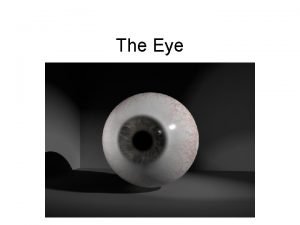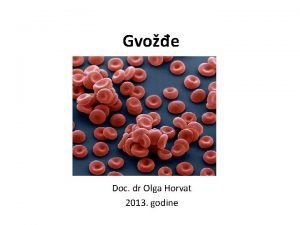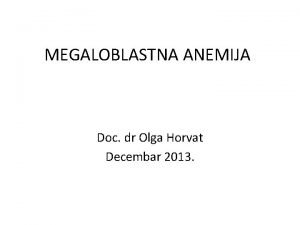RETINAL DETACHMENT Marina Capak Mentor A mega Horvat




















- Slides: 20

RETINAL DETACHMENT Marina Capak Mentor: A. Žmegač Horvat

RETINA • light-sensitive layer of tissue • sends visual messages through the optic nerve

• pulled away from the underlying choroid • small areas of the retina torn => retinal tears or retinal breaks • retinal cells deprived of oxygen • if not promptly treated => permanent vision loss

SYMPTOMS • floaters - bits of debris in field of vision that look like spots, hairs or strings


SYMPTOMS • floaters • light flashes • shadow or curtain over a portion of visual field • blur in vision

Can occur as a result of: • trauma • advanced diabetes • an inflammatory disorder, such as sarcoidosis • shrinkage of the jelly-like vitreous that fills the inside of the eye

• vitreous liquid leaks through retinal tear and accumulates underneath retina • retina can peel away from underlying layer of blood vessels

Factors that may increase risk of retinal detachment: • • • aging - more common in people older than 40 previous retinal detachment in one eye family history of retinal detachment extreme nearsightedness previous eye surgery previous severe eye injury or trauma

TREATMENTS Retinal tears: • laser surgery (photocoagulation) • freezing (cryopexy) Retinal detachment: • pneumatic retinopexy • scleral buckling • vitrectomy

PHOTOCOAGULATION

CRYOPEXY

PNEUMATIC RETINOPEXY

PNEUMATIC RETINOPEXY

SCLERAL BUCKLING

VITRECTOMY

When a surgeon injects a bubble of expandable gas into the vitreous cavity it is called: • • • scleral buckling vitrectomy pneumatic retinopexy photocoagulation cryopexy

Retinal detachment can occur as a result of; • Obesity • Trauma • Nearsightedness

When a surgeon uses intense cold to freeze the retina around the retinal tear it is called; • Scleral buckling • Vitrectomy • Pneumatic retinopexy • Photocoagulation • Cryopexy

• http: //www. nei. nih. gov/health/retinaldetach/ • http: //www. mayoclinic. com/health/retinaldetachment/DS 00254 • http: //emedicine. medscape. com/article/7985 01 -overview
 Marina capak
Marina capak Nursing diagnosis for impaired swallowing
Nursing diagnosis for impaired swallowing Retinal detachment
Retinal detachment Retinal detachment presentation
Retinal detachment presentation Retinal detachment
Retinal detachment Nursing management of encephalitis
Nursing management of encephalitis Anterior hyaloid membrane
Anterior hyaloid membrane Nanda nursing diagnosis for eye disorders
Nanda nursing diagnosis for eye disorders Marina horvat pavlic
Marina horvat pavlic Lara horvat
Lara horvat Anulociti
Anulociti Dscabies
Dscabies Jelena horvat
Jelena horvat Iva horvat radman
Iva horvat radman Maria horvat md
Maria horvat md Magdalena horvat
Magdalena horvat Intermediarno dedovanje
Intermediarno dedovanje Olga horvat
Olga horvat Binocular cues
Binocular cues Retinal break
Retinal break Gerak sakadik
Gerak sakadik






































